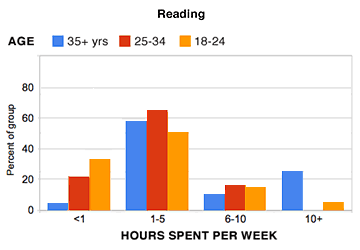Generation gap
I've spent the past few days reading over responses from students to our Learning Design, Learning Software survey. I have to admit that I'm a little surprised at how generally happy they are with how they are being taught in their design classes. Of 237 responses, 65% are Satisfied/Very Satisfied. Only 16% are Not Satisfied or Really Unhappy. Maybe it's because you tend to remember those who complain, but I expected the latter number would be higher.
It's answers to another group of questions that have gotten me thinking, though. When asked how much time they spend per week doing various things (Watching TV, Reading, etc.) there's a huge difference in two areas: Reading, and the Social Web.
Reading
 The conventional wisdom is that younger students read less, and sure enough that's what we see. But notice the similarity: most students of all ages fall in the 1-5 hours per week category.
The conventional wisdom is that younger students read less, and sure enough that's what we see. But notice the similarity: most students of all ages fall in the 1-5 hours per week category.
Notable differences lie at either end: 33% of young students spend an hour or less reading, while nearly as many (26%) of older students spend 10 or more hours. I think there's a warning for teachers here, but more on that later.
Social Web
 There's a whole category of web-related activities called "social-networking." This includes community sites like MySpace and Facebook as well as communication tools like Twitter.
There's a whole category of web-related activities called "social-networking." This includes community sites like MySpace and Facebook as well as communication tools like Twitter.
Predictably, younger students are more active in this area, but the difference between age groups is much more dramatic than with reading. Notice that most younger students of all ages spend some time on social sites, while older students are nearly unanimous in not doing so.
I don't want to overstate the value of social networking, because the jury is still out on that, but it concerns me that the 35+ age group seems to be totally boycotting this activity. It would be even worse if teachers—likely to be in that 35+ age group—are equally uninvolved.
Questions for teachers
Unfortunately I didn't ask these questions in my survey for teachers, so I'm just guessing here, but... I suspect that teachers in the 35+ group (virtually everyone I've talked with) share similar attitudes toward reading and social networking as their students. In other words, a lot of teachers really like reading and books, and are totally disinterested in MySpace and Facebook.
Here's the potential problem with this disconnect: we know that younger students don't read much (see above), yet the only learning aid required in a significant number of classes is a book. 43% of classes had required books, while less than 8% required either video or online tutorials. If students don't read much but do spend more time online and/or watching TV, does this make sense?
The social networking issue centers around the idea of trying to reach students in ways that make sense to them. If 70% of students spend more than an hour a week on social networking sites, shouldn't we be using these sites as part of our educational mix? Even if you don't find MySpace or Facebook all that appealing, what about trying to integrate them into your classes in some way?
All of this relates to the Digital Native, Digital Immigrant divide, which I'll be exploring more in the future. Stay tuned...
![]() Add your comment by clicking below.
Add your comment by clicking below.
Top |
|
![]()